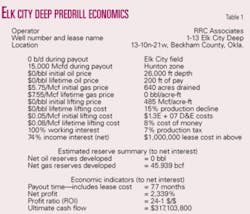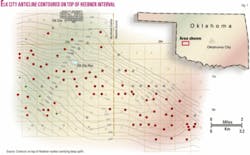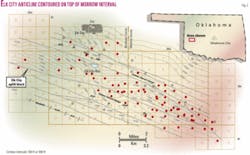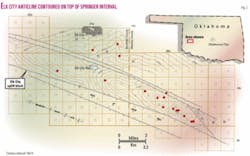The Elk City anticline is perhaps the largest structure in the deep Anadarko basin without a test well to the Siluro-Devonian Hunton formation.
This could soon change as a Houston company has proposed a 3D seismic survey that would include the uplift and nearby lands.
Based on Northeast Mayfield Hunton field, a smaller but similar structure 15 miles west where ultimate recoveries are expected to range up to 113 bcf/well, Elk City offers the promise of being the largest deep gas reservoir in the state and possibly in the Mid-Continent Region.
Elk City’s gas recovery potential is estimated at more than 1 tcf in the Hunton alone, and deeper zones could double this volume.
Elk City production
Drilling costs to the Hunton at 26,000 ft are substantial at $12-15 million for the initial test, and the potential rewards are far greater.
A successful well is estimated to return over $300 million in cash flow (EBITDA, Table 1). Subsequent wells should see drilling/completion costs drop, affording even more attractive economics.
No Arbuckle test has been drilled in Roger Mills County, north of Beckham County, or Washita County, east of Beckham. Only one has been drilled in Beckham within the confines of the Deep Anadarko basin proper.
The prospective Elk City uplift is just north of the basin’s axis in an area where at least five major gas transportation systems are accessible, an area with widespread oil and gas infrastructure.
Shell Oil Co. first discovered shallow hydrocarbons at Elk City in the Pennsylvanian Hoxbar formation at 9,300 ft in 1947. By 1956, 328 wells had been drilled with 302 completed. Now a large portion of Elk City oil and gas field is under secondary recovery by XTO Energy Corp. Current production is 3,500 bbl/month of oil and 102 MMcf/month of gas.
Other production is found in the Granite Wash and conglomerates from 9,500 ft to 14,600 ft. Also, both Upper and Lower Morrow sands, at 15,500 ft and 18,000 ft, respectively, have produced gas along a 22-mile fairway that coincides with the deep structural axis of the Elk City uplift.
Springer sands have been found productive in the eastern portion of the trend. The western part has room for more drilling.
Geological detail
Geologic mapping reveals structural closure in each zone from the shallow Heebner to the Morrow and Springer.
Most deep structures in the basin have shallow structural anomalies over them. In this case, the shallow Heebner marker at Elk City exhibits more than 400 ft of closure (Fig. 1).
Mapping at the Morrow level reveals a sharp structural horst bounded by a large fault complex on the north side and a series of down-to-the-basin faults along the southern flank. Over 3,000 ft of relief is mapped from the crest of the uplift to the downthrown northern block (Fig. 2).
The Springer, the deepest marker with adequate log control, is affected by the same structural uplift and faulting as the Morrow and reveals an elongate closure of over 1,200 ft. The indicated structure is a narrow, NW-SE trending feature some 2 miles wide and 13 miles long. The configuration is very similar to that of the Morrow (Fig. 3).
When this configuration is projected to the Hunton, it reveals a potential productive area some 13 miles long. This is over twice the length of Northeast Mayfield Hunton field and is comparable in size to the Mills Ranch-Mayfield Hunton and Arbuckle complex 26 miles to the southwest in Wheeler County, Texas Panhandle.
Casing program
To successfully drill a 26,000-ft well in the Anadarko basin requires a carefully engineered casing program.
Overpressured and underpressured zones are present, and both can be encountered in a given well.
In addition, massive carbonate sections may contain traces of hydrogen sulfide. Gas from the Hunton formation has tested up to 13 grains of H2S/100 cf, although this is not present in every well (Table 2).
The basin, while relatively deep, is also relatively cool. This is in the operator’s favor because excessive temperatures can adversely affect open hole logging, mud programs, and cementing. The average geothermal gradient is estimated at 21° C./km of depth, according to Lee Demming of the University of Oklahoma.
Reserves and economics
As stated, this is an extremely large structural feature with the potential for exceedingly large gas reserves.
Northeast Mayfield, although smaller, is used as an analogy because it is a similar narrow, fault-bounded structural trap. In Northeast Mayfield, 7 producing Hunton wells have cumulative production of 276 bcf, an average of 39 bcf/well.
Ultimate recovery is estimated at 548 bcf or an average of 78 bcf/well. Volumetric reserves for Elk City, based on 200 ft of pay, are estimated at 61 bcf/well with a possibility of 27 productive Hunton locations. ✦
The author
Roy Ross Cottrill ([email protected]) is an independent petroleum geologist in Tulsa. His industry career with Cities Service, Sunray D-X, and Sun Oil took him across the Mid-Continent, Michigan basin, Gulf Coast, and Rocky Mountains. He specializes in the Deep Anadarko basin. He became independent in 1980. He has a BSc in geology from Michigan State University.





